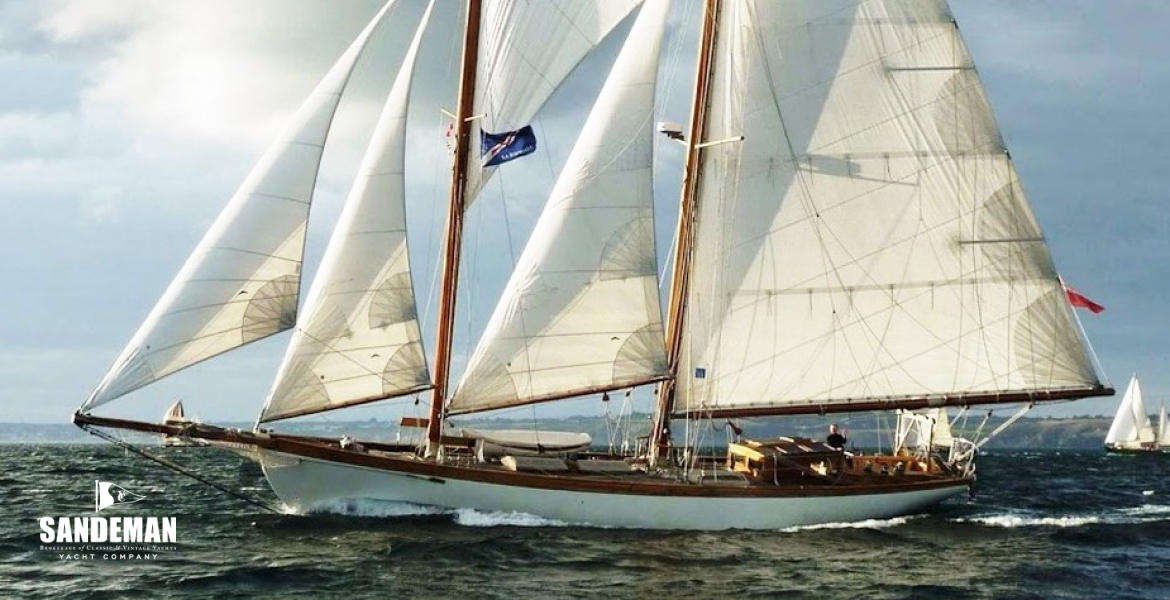
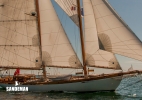
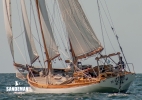

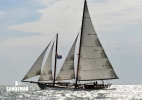


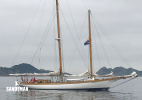

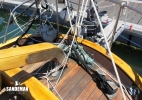


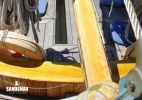
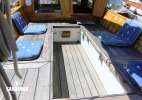
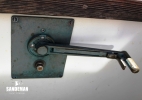
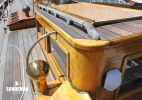
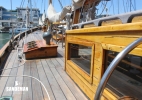
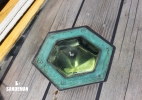
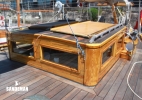
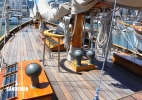
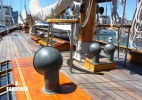

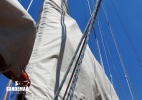
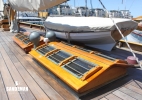
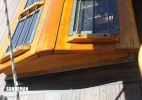
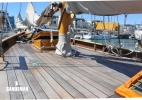
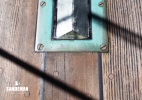
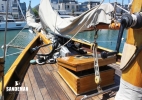
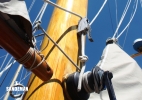
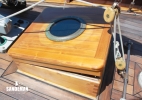
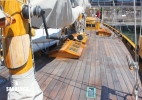
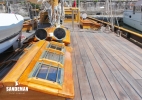
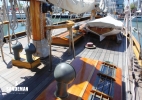
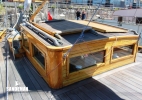
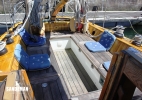

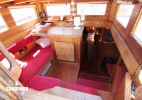
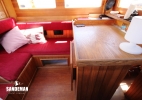
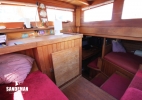
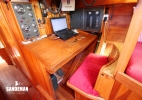
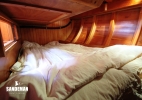
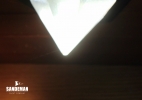
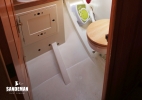
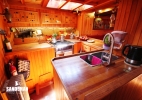
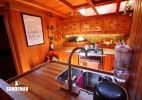
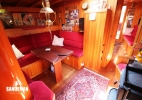
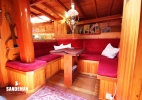
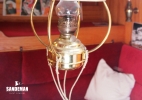
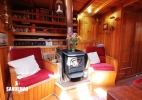
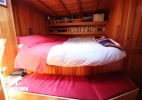
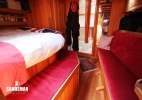
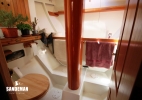
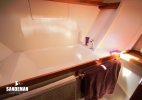
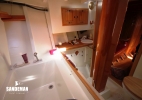
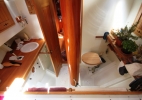
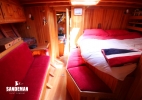
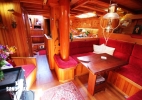
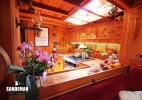

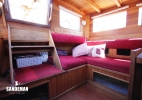
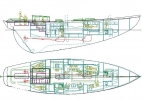
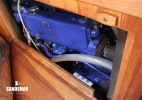
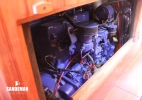
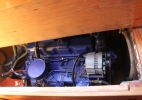
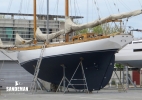
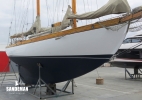

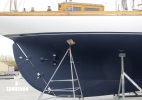
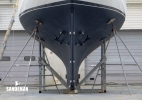

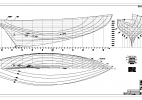
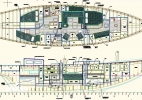
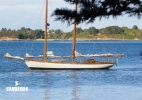
| Designer | Starling Burgess |
|---|---|
| Builder | Covey Island |
| Date | 2004 |
| Length overall | 80 ft 0 in / 24.38 m |
| Length deck | 59 ft 0 in / 17.98 m |
| Length waterline | 50 ft 0 in / 15.24 m |
|---|---|
| Beam | 15 ft 3 in / 4.65 m |
| Draft | 10 ft 0 in / 3.05 m |
| Displacement | 40 Tonnes |
| Construction | Composite wood/ epoxy |
| Engine | 2 x Ford New Holland Diesel 85 hp each |
|---|---|
| Location | France |
| Price | GBP 450,000 |
These details are provisional and may be amended
If you want to build a new, traditional, easily-handled by a couple, performance schooner yacht of around 60 feet, and feel like doing something just a little bit different instead of another Alden Malabar, what better model to replicate than the W. Starling Burgess-designed staysail schooner NIÑA, once described by Olin Stephens as, “the only boat he knew of that looked good from any angle”, and surely among the top ten most iconic yachts of all time... The original NIÑA was designed to fit the handicap rule in force for the 1928 Queen of Spain Cup race from New York to Santander; fortuitously, Burgess’s take on that rule allowed a yacht that would not only perform under it, and perform period - and in the days when sea-kindliness still prevailed - but also with a very easily handled rig, even by a couple. NIÑITA’s owners wanted such a yacht, and, using the original hull lines and rig drawings provided by Mystic Seaport Museum, had her built of strip plank Douglas fir/ epoxy by one of the great schooner builders of the modern age, well experienced with this immensely strong build method. Since launching in 2004, NIÑITA has been in almost constant commission as a very able eastern north Atlantic cruiser and exceptionally comfortable floating home, with a Baltic cruise north of the Arctic Circle and many classic rallies and regatta wins - still just two-up - also included in her impressive sailing programme. NIÑITA is a striking, strong and well proven blue water cruiser with an amazing pedigree.
Interested in NIÑITA in more detail.
In his superb biography of the original's designer, 'No Ordinary Being - W. Starling Burgess: Inventor, Naval Architect, Poet, Aviation Pioneer, and Master of American Design' (2015 David R. Godine), author Llewellyn Howland III talks of:
“The peerless staysail schooner NIÑA! Nothing in Burgess’s portfolio before the design of NIÑA, not even the staysail schooner ADVANCE, can altogether explain the impact she would have on the sport of ocean racing. And perhaps no other boat, not even Olin Stephens’s early triumph, the yawl DORADE, or L. Francis Herreshoff’s grand ketch TICONDEROGA, won more races or sailed more sea miles over more decades than did the inimitable NIÑA.”
Her easily driven hull, elegantly short-ended to work the handicap rule, was the stable and very able platform to a then previously unseen rig design - a sort of cutter-headed schooner - that, whilst also contrived to work well under the rule and be more efficient upwind than the traditional schooner rig, had the added benefit of being very easily handled. We now know it as the staysail schooner rig, and it really worked: in her first season she won the Queen of Spain Cup transatlantic race from New York to Santander, Spain, and became the first American yacht to win the Fastnet Race.
In all respects the design was very well suited to purpose for NIÑITA - why should it not have been... it's only remarkable that it hadn't been done before - and this has been very well proven during fourteen years of quite intense and adventurous use by the commissioning owners under sail and as a home. Perhaps a summary of their sailing and regatta adventures is proof indeed:
2004
Launched 15th June, Shelburne, Nova Scotia.
Shelburne to Le Have River - Lunenburg – Atlantic passage to Horta, Azores
2005
Azores cruising - Brittany – southern England - Atlantic Spain and Portugal
2006
Atlantic Spain - Madeira - Azores - Brittany & Normandy – southern England – Netherlands - Baltic Germany and Denmark
2007
Baltic Germany – Sweden - Gulf of Bothnia – Finland – Germany – Normandy – Brittany
2008
Brittany – southern England – Ireland – Brittany
(incl Brest 2008)
2009
Brittany - Biscay – northern Spain – Azores – Madeira – Canaries
(incl ‘Semaine du Golfe’, Morbihan)
2010
Canaries – Azores – NW Spain – Brittany – south coast England – Scillies
(including ‘Coupe de Trois Phares’, ‘Trophée Harlé’ and ‘Classique Pavois’)
2011
Brittany – Channel Islands
(incl ‘Semaine du Golfe’, Morbihan, ‘Coupe de Deux Phares’, ‘Classic Channel Regatta’)
2012
Brittany – northern Spain – south coast England
(incl ‘Brest 2012’)
2013
La Rochelle – Atlantic Spain – Canaries – Madeira – Azores - Canaries
2014
Canaries – Azores – Brittany
(incl YCC Rally La Rochelle)
2015
Cruising Biscay France and Spain
(incl Port Louis (Lorient) Classic Regatta)
2016
Biscay France and north and north west Spain cruising
2017
Biscay France and Spain
(incl Basque Country rally with YCC)
©2025 Iain McAllister/ Sandeman Yacht Company Ltd.
Hull
Wood-epoxy strip plank construction, fully framed
- 44 mm Douglas fir strip planking externally sheathed with 3 layers of E glass cloth
- Minimum 200mm moulded Douglas fir backbone
- 70 x 60 mm laminated Douglas fir ring frames set on 410 mm centres
- External monolithic keel casting: 15 tonnes lead
- Keel bolts 316L Stainless steel
- 3 tonnes internal lead trim ballast
Deck
- 15 mm Strip-plank Douglas fir planking on epoxy glass sheathed 19 mm Douglas fir ply epoxy glued to 10 mm Nova Scotia pine; total 44 mm
(Builder's specification is available for more details.)
Deck layout
- Flush decked with 5 glazed opening deck hatches
- Large self-draining cockpit with raised black locust coamings
- Seating with wet lockers under
- Laminated ash balanced tiller steering; steering position sheltered by wheelhouse
- Black locust sheathed Douglas fir deckhouse
- All round view through certified and tested tempered glass lights
- Sail sheeting system designed for one person to manage from the steering position
- Deck mounted bronze headsail tracks, ash blocks
- Harken self-tailing winches
- Black locust skylights and Dorade boxes
- Black locust forehatch
Ventilation
- Via a 8 bronze Dorade cowl vents and one mushroom forepeak vent
Ground Tackle
- 110lb CQR anchor roller stowed part way out on bowsprit leading cable clear of bow
- 85m 13mm high tensile galvanised chain (new 2016)
- 75lb CQR anchor roller stowed part way out on bowsprit leading cable clear of bow
- Chain and nylon warp
Mooring
- Warps lead through 3 x per side Panama fairleads to stainless steel mooring bits
Self steering
- An Aries wind vane steering gear is fitted on the transom
- Tung-oiled Nova Scotia pine with American white oak trim and detailing.
- Galley worktops and cabin soles in Tung-oiled Douglas fir
Deckhouse
- Accessed from cockpit via sliding hatch, two doors, drop in panel and steps
- L shaped upholstered bench seating for 4, convertible to a pilot/anchor watch berth
- Large chart table for paper charts
- Fold down table
- Large single (or tight double) sea-going quarter berth at lower level to starboard side
- Solid sliding leeboard and curtains for privacy from deckhouse; extra chart stowage over
- Large stowage lockers under and behind steps for access to cockpit
"Downstairs" Chart Table
- To starboard below side deck at forward end of deckhouse
- Large chart table with chart locker under and upholstered seat
- Engine instruments, radar display, communications radios, electrical panel
Double Aft Cabin to port
- Opposite "downstairs" chart table: double cabin with large double bed
- Lockers, hanging locker, upholstered seat, deck prism
- Sliding window, escape hatch, ventilation through to deckhouse
Foul weather gear Hanging Locker
- Off aft end of corridor starboard, full height, deep
- Stowage shelves outboard
- Accessible either from door and/or from access door in washroom
Washroom/Aft Toilet
- To starboard opposite galley
- Separated by corridor running from deckhouse to saloon
- Ceramic basin, mixer tap and vanity unit with cupboard under
- Groco porcelain toilet with bronze pump to polypropylene holding tank
- Mirror over
Galley - to port, clockwise from aft
- U-shaped for secure cooking at sea
- Crockery storage racks behind cooker and fridge
- Food and drinks storage lockers above
- Built in top access fridge with freezer compartment
- 4 x Burner Force 10 propane stove with glass front oven
- Gas locker outside with overboard drainage
- Top access food locker
- Worktop aft of dinette which communicates with saloon
- Cutlery drawers and pan stowage below
- Double stainless steel sink unit on centre line with worktop aft
- Cutlery and kitchen items drawers under
Saloon - full width
To port
- U shaped dinette seating for 8 people around acacia dining table
- Bottle locker under
- Full length single pilot berth outboard
To starboard
- Waterford cast iron wood burning stove; hot plate; glazed door
- Armchairs either side of stove; bookshelves and stowage racks above and behind
- Large locker above aft armchair
- Stowage lockers under and behind all seating.
Full width Owner's Cabin
- 2 x Hanging wardrobes also containing clothes shelves
- Full length mirror on aft side of forward bulkhead
- Double bed to port
- Bookshelves and storage outboard
- Settee and dressing table to starboard
- Shelves and cupboards over.
Forward Bathroom
- Transverse bathtub with mixer tap and shower fitting
- Vanity unit to starboard with deck prisms above ceramic washbasin
- Cupboards over and under
- Mirror on aft bulkhead over basin
- Groco porcelain toilet with bronze pump to port aft
- Extendable foldaway workbench above and behind
- Tool locker over
Forepeak
- Self draining chain, warp and fender locker
- Sealed from accommodation.
Bermudian staysail schooner rig according to original Burgess sail plan
- Hollow Douglas Fir masts stepped on keel
- Bowsprit, staysail booms and mainsail boom all epoxy glued solid Douglas Fir
- Stainless steel wire standing rigging
- Mix of polyester and Dynema running rigging
- Self-tailing Harken winches/ clutches at both masts for halyards, topping lifts and mainsail reefing.
Dacron sails; all except Fisherman and Storm Jib stow on booms and bowsprit under covers
- Main (3 x reefs), main staysail, fore staysail, jib by Incidences
- Fisherman and storm jib by Rolly Tasker
Engine and drive train
- 2 x Ford New Holland naturally aspirated slow revving diesel engines
- 1 Engine under galley furniture; 1 engine under forecabin furniture
- Each developing 85 hp at 2000 rpm
- 2 x PRM hydraulic reduction gearboxes
- Traditional drive trains; 1¾ inch 316L stainless steel shafts
- 2 x Gori 3-bladed folding propellers on conventional straight
- Max speed under engines approx 10 knots
Fuel Tankage
- Fuel capacity 1150 litres in 2x 316 stainless steel tanks with multiple choice supply/ return
- Economical cruising speed: 5 to 6 knots on one engine at 850 rpm: 3 litres/hour
- Maximum range under engine, about 2000 miles
Batteries and charging
- Engine start battery at each engine
- Two Surette 8D conventional deep cycle wet lead acid batteries for 12 volt electrical system
- 12 volt 50 amp battery charger
- 220V shore power battery charger
- Diodes and switching system for battery separation/isolation charging
- 100 Watt Ampair/ Aquair alternator for maintaining 12 volt system whilst sailing
- 2 x Small inverters
- 1 x for 240 volts; 1 x for 110 volt (US) (laptop navigation, small appliances)
Electrical
- 220V shore power mains system; European sockets; wall mounted halogen/ LED lamps
- 12 volt LED lighting system incl red night lights
Water tankage
- 2 x 600 litres 316 steel
- 1 x engine or 220V immersion heated calorifier tank
Domestic pump-out
- Auto electric for galley sinks
- Switched electric for bath
- Manual for wash hand basins
Oil lamps
- 7 x Traditional brass oil lamps
Other than as stated below, navigation is by owners' personal instruments i.e. personal laptop computer with MaxSea, sextant, charts, towed log etc. which are not included in sale inventory
- Depth Sounder
- Furuno Radar
- VHF tranceiver
- Built in AIS with VHF antenna inside main mast
- Output signals to a laptop with a navigation program via USB
- 4-Person Plastimo offshore liferaft
- 2 x Horseshoe lifebuoys with lamp
- Fire extinguishers
- Electric and hand operated bilge pumps
- 10ft clinker pine on oak spritsail-rigged centreboard sailing tender
- Mahogany transom, gunwale, rudder and knees
- Cradle stowage on starboard side deck
Contact us to discuss NIÑITA in more detail.
These particulars have been prepared from information provided by the vendors and are intended as a general guide. The purchaser should confirm details of concern to them by survey or engineers inspection. The purchaser should also ensure that the purchase contract properly reflects their concerns and specifies details on which they wish to rely.